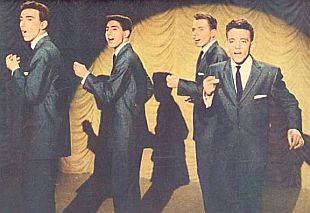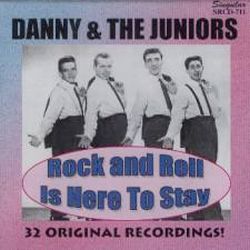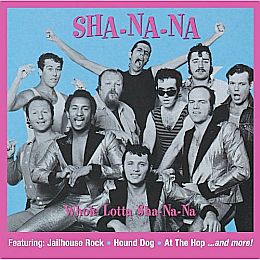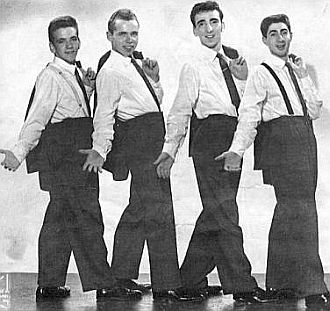
Danny & The Juniors – from left, Danny Rapp, Dave White, Joe Terranova, and Frank Maffei – rose to fame in the late 1950s with “At The Hop.”
Initially, Dave White helped to form the group. He was the son of a show business couple who did an acrobatic routine. Dave had hung out with some black kids in the area who were then singing a new kind of harmony. “I knew church music, and I knew how to read music,” White would later recount to the Los Angles Times. “They taught me the R&B and rock ‘n’ roll element. I was so excited about it that I went around and found guys in my neighborhood who could sing.”
The four boys sang at school parties and other local functions. They practiced whenever they found time — in their cars, in the school hallways, wherever. One night they decided to go to a street corner where a local record producer named John Madara lived. After telling the boys to “get lost” a few times, Madara finally went downstairs for a listen. The boys weren’t bad, he thought to himself. In fact, they were good enough for an introduction to local disc jockey, Larry Brown, and his partner, Artie Singer, who had a record label, Singular Records. It was 1957.
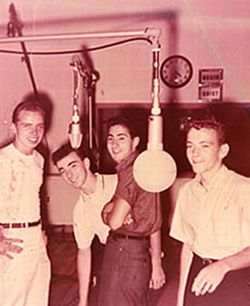
The young and hopeful Danny & The Juniors in a recording studio, 1957.
At the time, the boys called themselves the Juvenaires, and they had come up with a couple of songs. One was a ballad titled “Sometimes.” Another was a dance tune titled “Do the Bop,” written by group member Dave White. Artie Singer liked “Do the Bop,” and had the group soon cut a demo for him to test with local DJs.
Singer took the record to a friend for an opinion — a friend who happened to be Dick Clark of the new Philadelphia TV dance show, American Bandstand.
Clark, in addition to hosting Bandstand, was also a radio DJ. Danny and the Juniors’ member Joe Terranova, who later renamed himself Joe Terry, recalled that the Philadelphia record business at that time was pretty hot. Producers were turning out new recordings by the dozens. And when the local DJs would give selected recordings air time, “they would sell 50,000-60,000 copies,” said Terry. “They really didn’t care if it was a national hit or not. They were making money doing it that way.”(i.e., locally).
First Record
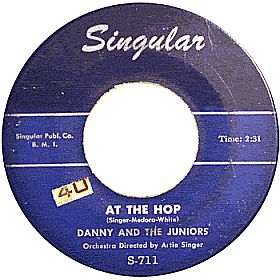
The first recording of “At The Hop” in 1957 was on the Singular Records label of Philadelphia. Click for vinyl.
Music Player
“At The Hop”- Danny & The Juniors
In any case, with Clark’s advice, the Juniors’ song was renamed “At The Hop.” It was then re-recorded and the group also changed their name to Danny & The Juniors. Producer Artie Singer put the record out on his Singular Records label. In a 2007 You Tube clip, from a longer documentary on Dick Clark and the payola scandal, Singer says on camera that Dick Clark asked for 50 percent of publication rights to “At The Hop” as a condition for playing the record. But when “At the Hop” first came out, it didn’t get much attention. That would soon change, however.
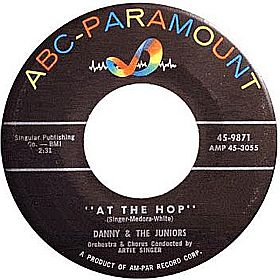
After Danny & the Juniors appeared on ‘Bandstand’ in Dec 1957, ABC’s Paramount record label acquired the rights to “At The Hop,” which became a No.1 hit, selling 2 million copies. Click for digital.
Bandstand Calls
Dick Clark’s Bandstand TV show, meanwhile, had taken off. Beginning as a locally-broadcast Philadelphia show, Bandstand had become the highest rated local daytime show in the nation. Network TV executives in New York had taken notice. The ABC network decided to take the show national.
By August 1957, now called American Bandstand, ABC began broadcasting the show nationwide at 3 p.m. for an hour-and-a-half. Within six months of going national, American Bandstand was picked up by 101 stations. Twenty million viewers were now tuning in, and 20,000-to-45,000 fan letters were arriving each week. Teenagers came from all over the country to dance on the show. But Bandstand was also a place where new talent could be seen; a place where aspiring artists could get their start. Danny & The Juniors, still laboring in the back bench of struggling Philadelphia singing groups, were about to get a big break.
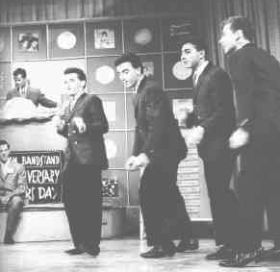
Danny & the Juniors appearing on “American Bandstand,” with Dick Clark at the podium, 1950s.
ABC’s Paramount record label quickly became aware of the popular new song, bought up the master recordings, and re-issued the single under its ABC-Paramount label. By December 9th, 1957– a week after Danny & The Juniors had made their “emergency” fill-in appearance on Bandstand — “At The Hop” hit the Billboard pop chart, and within a month it was the No. 1 record in America.
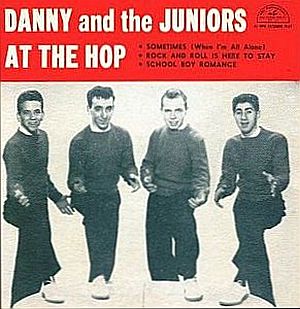
Record sleeve for Danny & the Juniors’ extended play 45 rpm with four songs: "At The Hop," "Rock and Roll Is Here To Stay," "Sometimes" and "School Boy Romance," 1958.
According to one listing at Billboard magazine, “At The Hop” is ranked the 23rd all-time, best-selling record.
On Bandstand, meanwhile, Danny and the Juniors became frequent guests on the nationally- telecast show, reportedly making dozens of appearances. They also appeared on other television shows. On January 2, 1958, they appeared on “The Pat Boone Chevy Showroom” singing “At The Hop.” They also made appearances on “The Patti Page Big Record Show” and “Nashville Now,” among others. And they toured with famous radio DJ, Alan Freed, and his rock ‘n roll revue. In June 1958 they made their Hollywood debut in the Columbia Pictures’ film, Let’s Rock, starring Julius LaRosa, who plays a mainstream singer attempting to fight off the rising new sound of rock ‘n roll music.
Life Changes
After “At the Hop” had risen to top the charts, and the group had a national hit, life for the four young Philadelphia teenagers quickly changed. In a retrospective interview with Joe Terry (Terranova) years later, some of the group’s early experiences were described:Q: “How did life change for you when ‘At The Hop’ went to number one?”
A: “We had some major decisions to make. Myself, being that I was still in high school, so I had to decide whether I was gonna’ come out of high school and forego a college education and go into show business. So, life changed drastically. My goal was to go to Drexel University and become a draftsman / architect. That was a big decision that we all had to make. Dave had a scholarship to one of the universities. I don’t think Frank had any college plans, nor Danny. We went into a world where we were working tours almost every night for at least a year and a half. So, you give up your teen-age youth and become an entertainer. And that’s what happened…”.
Second Hit
The follow up to “At The Hop” was a song called “Rock ‘n Roll Is Here to Stay,” which also has its own asterisk in rock ‘n roll history. In 1957-58, rock ‘n roll music wasn’t being well received throughout all corners of America. On T.V. in 1957, for example, Ed Sullivan’s producers decided that Elvis Presley could only be seen on camera from the waist up, as they considered his hip movements too suggestive. In Chicago that year, Cardinal Stritch of the Catholic archdiocese, prohibited the playing of all rock ‘n roll music in the church’s schools, fearing that “its rhythms encourage young people to behave in a hedonistic manner.” And in January 1958, St. Louis radio station KWK, had all rock ‘n roll music banned from its play list. The disc jockeys there — during a much-promoted “record-breaking” week — ceremoniously gave every rock ‘n roll record in the station’s library a “farewell spin” before smashing them to pieces. The station manager, Robert Convey, called the action “a simple weeding out of undesirable music.”Danny & the Juniors’ “Rock ‘n Roll Is Here to Stay,” was written in re- sponse to St. Louis KWK radio station’s ban on rock ‘n roll music and its on-air smashing of records. Danny and Juniors “Rock ‘n’ Roll Is Here to Stay” was reportedly written in response to the radio station’s actions, and for a time, the song became something of a rock ‘n roll anthem. Written by Dave White, the song rose to No.19 on the music charts and became the group’s only other U.S. Top 20 hit. The song would also be used in the 1978 film soundtrack for Grease.
In 1960, Danny & the Juniors were signed to Dick Clark’s Swan Records label and they released “Twistin’ USA,” which made it into the Top 40, becoming their final hit single. They went on to release more singles, including “Pony Express” and nine other songs that would chart on Billboard’s Hot 100 list, but none of these repeated the success of their first two songs. “At The Hop,” however, would live again in future years, and would come into vogue on several occasions as rock ‘n roll nostalgia emerged in the U.S. and U.K.
In the 1973 movie, American Graffiti, which was set in part the late 1950s rock ‘n roll era, a scene at a senior class dance is featured with a look-alike band playing Danny & the Juniors’ “At the Hop” song. In 1976, nearly 20 years after its debut, “At the Hop” was re-issued in Britain where a wave of 1950s nostalgia had taken hold, propelling the tune back on the charts, reaching No. 39.
Later Years
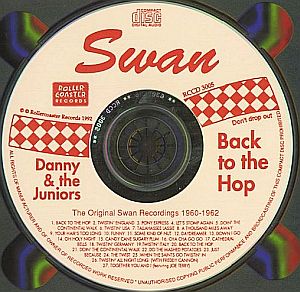
CD label for “Back to the Hop,” a collection of 26 various recorded and studio cuts of Danny & The Juniors’ music with Swan Records during the 1960-1962 period, by Roller Coaster Records, U.K., 1995 and as MP3 in 2003. Click for CD.
Dave White Tricker (his full name) and Madara split up in the mid-60s, and White hit the skids for a time and couldn’t pay the rent. So he moved to a New Jersey farmhouse and began working with a rock band called Crystal Mansion. About that time, his old singing buddy, Danny Rapp made him an offer to join a reunited Danny and the Juniors for some Las Vegas work organized by Dick Clark. “Danny called me up and said, ‘We can get $10,000 a week,’ and I didn’t have two cents,” White said, describing the call in a later interview. But White decided not to rejoin Danny, and in 1971 released a solo album in the mellow singer genre, but it was not a chart-buster. Then in 1978, rock ‘n roll nostalgia took off, and “At the Hop” found its way onto the hit soundtrack for Grease, yielding songwriting royalties for White. His Crystal Mansion group, meanwhile, signed a recording deal with 20th Century Fox records. White then went to Los Angeles and pumped his royalty money into his new band. But soon, the money ran out. “All of a sudden my sixty grand that I got from Grease [was] gone.” Crystal Mansion, meanwhile, was put on the backburner at Fox and White then took some film courses at UCLA. In 1982, White again met Danny Rapp, this time at a Lake Tahoe lounge where Danny was then performing with a new lineup of Juniors. The brief reunion went well, and White even went onstage and sang a couple of numbers with the group, but decided against going back with Danny, although tempting at time. White had resolved to himself he would only go back on the road if he had to, as a last resort. His songwriting royalties from what he had written in the ’50s and early ’60s was enough to keep him afloat.
|
Danny’s Suicide In early April 1983, in a motel room in Quartzsite, Arizona near Pheonix, the body of Danny Rapp was found. He was the victim of an apparent gunshot suicide. Rapp had been doing some performing in the early 1980s, and was then in Pheonix for a schedule of shows. But Rapp had not been seen for a few days, and failed to appear for scheduled performances in Pheo- nix. As the frontman for Danny & the Juniors, Rapp sang lead with the rock n roll group until they broke up in the mid-1960s. In the 1970s he briefly had a radio show in Camden, New Jersey. In later years, he became assistant manager in a toy factory. Rapp was born in Philadelphia in May 1941. He was 42 years old at the time of his death. |
Joe Terry, meanwhile, had received a phone call from Danny Rapp in Arizona around Christmas of 1982, shortly before his suicide. “He was just on the road, pounding it out,” Terry said. “He said, ‘I’m tired, I’m coming off the road.’ There was no hint, other than the fact he was tired, that he was going to do anything like that.” White and Terry later described Rapp as troubled, given to drinking binges on occasion and other out-of-control behavior. “He had a lot of personal problems — a divorce he never quite got over,” Terry would say.
By the late 1980s, Dave White was trying to score with some music video work. Still, his old music was keeping him afloat. The songs he had written with Madara in the 1960s would be periodically revived by new artists, helping his songwriter royalties to flow again. In 1988, “You Don’t Own Me,” originally scored in the mid-1960s, had a lucrative revival in a new version by the British group Blow Monkeys — a song that was also included on the megahit Dirty Dancing sound track album. That one song produced more than $50,000 in royalties for White, with more in the offing. At the time, White then moved from a North Hollywood trailer park to a Newport Beach condo. He acknowledged that the periodic revival of his songs was “like an annuity or something,” helping to pay the bills. “It’s kept me going for 30 years, and I really appreciate it, ” he explained in 1988. “But you never know what you’re going to make next year. There was a time in there when I hardly made any money. Nostalgia wasn’t in…. Now, it’s hot again, but nostalgia could go into a decline. That’s why I’ve been trying real hard the last few years to come up with new hits.”
In later years, a reformed Danny & the Juniors featuring Joe Terry (Terranova), Frank Maffei and his brother, Bobby Maffei, began performing on the oldies circuit. This group continued performing into the 2000s. In 2002, for example, they performed in Honolulu, Hawaii at the Blaisdell Arena in a nostalgia-filled show that also featured the reformed oldies groups including the Coasters, Bill Haley’s Comets, and the Drifters. Some years later, however, in 2019, two of the original Danny & The Juniors group passed away — Dave White in March that year, and Joe Terry (Terranova) in April.
Sha-Na-Na
The “At-The-Hop” sound, however, and the Danny & the Juniors legacy would continue in the musical world for some years in various forms, sometimes as part parody. In addition to Dave White’s songwriting and later hits, the group’s saxaphonist, Lennie Baker, helped form a rock ‘n roll nostalgia/parody group named Sha-Na-Na. This group played “At The Hop” at the historic Woodstock concert in 1969. The new group was relatively unknown at the time and were performing covers of ’50s hits and “doo-wop” songs, including Danny & The Junior’s “Rock and Roll is Here to Stay.” At Woodstock, their performance of “At The Hop,” which preceded Jimi Hendrix, helped launch their career. Sha-Na-Na, among other things, would go on to have their own TV show, running from 1977 to 1982. They also appeared in the movie Grease and performed several songs in that film, including “Rock and Roll is Here to Stay.” Sha-Na-Na, in fact, would release 21 albums and remain active, with varying personnel, into the 2000s.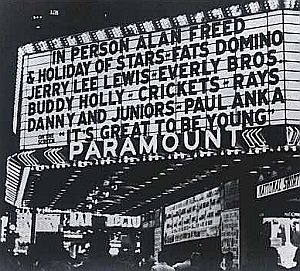
Theater marquee announcing acts in an Alan Freed rock 'n roll show, 1950s. Click for Alan Freed story.
______________________
Date Posted: 12 August 2010
Last Update: 18 April 2019
Comments to: jdoyle@pophistorydig.com
Article Citation:
Jack Doyle, “At the Hop, 1957-58,”
PopHistoryDig.com, August 12, 2010
____________________________
Sources , Links & Additional Information

CD cover for Billboard’s “Top Rock ‘n’ Roll Hits of 1958” – Rhino / Wea, October 1990. Click for CD.
Gary James, “Interview with Joe Terry of Danny & The Juniors,” ClassicBands.com.
Jay Warner, “Danny & the Juniors,” Vocal Group Hall of Fame, Induction, 2003.
Mick Patrick, “John Madara Interview,” SpectroPop .com
At least one 1958 tape of “At the Hop” by Danny & The Juniors has been captured in a You Tube clip.
Jay Warner, “Danny and The Juniors,” American Singing Groups: A History From 1940s to Today, 2006, New York: Hal Leonard Corp.,. pp. 142-143.
Danny and The Juniors website.
“Danny & The Juniors,”ThatPhillySound.com.
|
Danny & The Juniors American Bandstand The Dick Clark Show ________________________ |
“Danny & The Juniors,” Wikipedia.org.
“Phila. Singer Danny Rapp, 42,” Philadelphia Inquir- er, April 6, 1983, p. D-11.
Associated Press, “Singer’s Body Identified,” April 7, 1983.
Tim Ryan, “At The Hop,” Honolulu Star-Bulletin, Thursday, September 26, 2002.
Mike Boehm, ‘At the Hop’: A Lesson in Staying Power,” Los Angeles Times, March 6, 1988.
“Flip Side of Rock ‘n’ Roll,” Los Angeles Times, March 12, 1988.
David White (musician),” Wikipedia.org.
A documentary film, The Wages of Spin, chronicles the Philadelphia music scene from 1952 thru 1963. Dick Clark and American Bandstand are covered in the film, as well as the payola scandal of the late 1950s, including some film clips of the Congressional payola hearings. A clip from that film is available at You Tube. See also CharacterDrivenFilms.com.
|
Please Support Thank You |
_________________________
